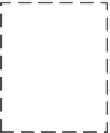Information Technology Reference
In-Depth Information
Fig. 2.
Flow chart for sub-channel allocation
2
7
5
4
8
……
6
3
Fig. 3.
A chromosome
2)Transform the chromosomes into a sub-channel allocation matrix: Since the gen-
erated chromosome cannot be used directly to evaluate the fitness function, it must
first be transformed into an allocation matrix. The chromosome shown in Fig. 2 can
be represented as a 864
matrix, with the elements in the matrix set to 0 or 1. Rows
represent user numbers, while each column represents a sub-channel number. For
example, if the element in the 5th row and 12th column is 1, it means that sub-channel
12 is assigned to user 5.
3)Evaluate the fitness function of each chromosome: The fitness function used is
given by (1) and the target is to achieve maximum system capacity and a rough rate
constraint for each user. Thus, the fitness of chromosomes is ranked based on the
value of the fitness function. A larger value has a higher rank while the chromosome
beyond the rate constraint requirement has the lowest rank.
4)Generate a new population by the following steps:
a)Selection: In the first generation, W chromosomes are randomly generated and
assigned a fitness rank by step 3. In this step, the chromosomes with the lowest fitness
ranks based on the selection probability Ps are abandoned; in other words, W*Ps
chromosomes with the lowest fitness ranks are discarded.
b)Crossover: The remaining chromosomes are randomly grouped into pairs. For
each pair, two new chromosomes are created using one-point crossover with crossov-
er probability Pc, and the new individuals are called children.
c)Mutation: The mutation operator is used to alter one or more genes in the chro-
mosome from its initial state to maintain individual diversity with mutation probabili-
ty Pm. By following the above steps, a new generation with W chromosomes is
formed.
×


































































